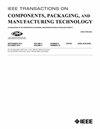Investigation of Gold-Silicon Eutectic Bonding to Realize the Symmetric Sensing Element of MEMS Piezoresistive Accelerometer
IF 2.3
3区 工程技术
Q2 ENGINEERING, ELECTRICAL & ELECTRONIC
IEEE Transactions on Components, Packaging and Manufacturing Technology
Pub Date : 2025-02-24
DOI:10.1109/TCPMT.2025.3545281
引用次数: 0
Abstract
In this article, we investigate the intermixing of gold-silicon (Au-Si) across the Chromium (Cr) adhesion layer for Au-Si eutectic wafer bonding process development. In the first experiment, a stack of Cr and Au film was deposited on a silicon wafer, annealed in nitrogen gas ambient followed by the etching of unreacted Au, and investigated using optical microscopy, scanning electron microscopy (SEM), and energy-dispersive X-ray (EDX) analysis. The study confirms the intermixing and formation of Au-Si alloy. With that understanding, the Au-Si eutectic wafer bonding process was developed to realize a new symmetric sensing element for a micro electro mechanical systems (MEMS) piezoresistive accelerometer. This structure is realized by bonding two silicon wafers containing complementary halves of the structure and Au-Au facing bond interface. Each half was formed by deep reactive ion etching (DRIE) in silicon-on-insulator (SOI) wafers. The DRIE-based method results in a smaller die size and eliminates the need for corner compensation, unlike potassium hydroxide (KOH) or tetramethylammonium hydroxide (TMAH)-based wet etching of silicon, and it enables the fabrication of even a cylindrical seismic mass. Post bonding, the interface was investigated using SEM, high-resolution X-ray imaging, and MIL-STD-883-based die shear test. The structure was successfully realized, achieving a 100% dicing yield of bonded wafers. For the 12 tested samples, the minimum, maximum, average, and standard deviation of die shear strength are 18.3, 40.1, 28.9, and 6.9 kgf, respectively. The average shear strength per unit of bond area is 27 MPa.研究金-硅共晶键合以实现 MEMS 压阻式加速度计的对称传感元件
在本文中,我们研究了金-硅(Au-Si)在铬(Cr)附着层上的混合情况,以开发金-硅共晶晶圆键合工艺。在第一个实验中,在硅晶片上沉积了一层铬和金薄膜,在氮气环境中退火,然后蚀刻未反应的金,并使用光学显微镜、扫描电子显微镜(SEM)和能量色散 X 射线(EDX)分析进行研究。研究证实了金硅合金的混合和形成。有鉴于此,我们开发了金硅共晶晶圆键合工艺,以实现微电子机械系统(MEMS)压阻加速度计的新型对称传感元件。这种结构是通过键合两个硅晶片实现的,其中包含互补的两半结构和面向键合界面的金-金。每一半都是在硅绝缘体(SOI)晶片上通过深反应离子蚀刻(DRIE)形成的。与氢氧化钾(KOH)或氢氧化四甲基铵(TMAH)为基础的硅湿法蚀刻不同,基于 DRIE 的方法可使芯片尺寸更小,且无需边角补偿,甚至还能制造出圆柱形地震块。接合后,使用扫描电子显微镜、高分辨率 X 射线成像和基于 MIL-STD-883 的模具剪切测试对界面进行了研究。该结构已成功实现,粘合晶片的切割率达到 100%。在 12 个测试样品中,芯片剪切强度的最小值、最大值、平均值和标准偏差分别为 18.3、40.1、28.9 和 6.9 kgf。单位粘合面积的平均剪切强度为 27 兆帕。
本文章由计算机程序翻译,如有差异,请以英文原文为准。
求助全文
约1分钟内获得全文
求助全文
来源期刊

IEEE Transactions on Components, Packaging and Manufacturing Technology
ENGINEERING, MANUFACTURING-ENGINEERING, ELECTRICAL & ELECTRONIC
CiteScore
4.70
自引率
13.60%
发文量
203
审稿时长
3 months
期刊介绍:
IEEE Transactions on Components, Packaging, and Manufacturing Technology publishes research and application articles on modeling, design, building blocks, technical infrastructure, and analysis underpinning electronic, photonic and MEMS packaging, in addition to new developments in passive components, electrical contacts and connectors, thermal management, and device reliability; as well as the manufacture of electronics parts and assemblies, with broad coverage of design, factory modeling, assembly methods, quality, product robustness, and design-for-environment.
 求助内容:
求助内容: 应助结果提醒方式:
应助结果提醒方式:


